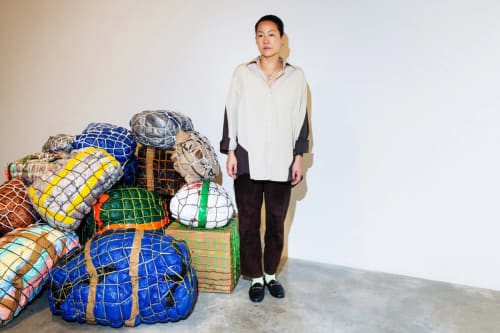The morning after the opening of her solo exhibition “The skin of the earth is seamless,” Maia Ruth Lee was back at Tina Kim Gallery in Manhattan, cup of coffee in hand.
“I was really surprised at the feedback,” says Lee, who relocated from New York to Colorado with her family right before the pandemic. “I think people are very curious. People are surprised. Most of the people who know my work, don’t know this side of my work at all. So this was really the first time, especially in New York, that they had seen the side of my work — especially these paintings.”
The exhibition marks a continuation of Lee’s “Bondage Baggage” series that she started in 2018, informed by her childhood growing up in Nepal. The earliest sculptural pieces in that series were shown alongside her glyphs work “Labyrinth,” a grid of symbols evocative of ancient written language. “I have a very strong connection to exploring identities within language and translation,” she adds.
Lee’s parents, who work as translators, relocated the family from South Korea to Nepal when Lee was five, and she lived there before relocating to New York as a young adult. Visiting her parents as an adult, Lee took notice of the luggage that came down the airport conveyor belt in Kathmandu: colorful bundles of household materials like bedsheets and tarps secured with tape and rope. She began documenting the luggage over the course of about five years.
“That sparked the interest of not only migratory experiences, but self-preservation, privacy protection, family, labor,” says Lee, adding that the luggage method is a preventative method against airport theft, used by many migrant workers returning to Nepal.
On view at Tina Kim gallery are sculptural replicas of the luggage, stacked in piles in the front gallery, as a video plays on one wall. On another wall and continuing into the next gallery space is a series of paintings transformed from the bundle sculptures, along with “empty” mesh-wire bundles.
When Lee began the series, her studio was based in Brooklyn. “We’ve definitely questioned ‘Do we come back?’ But the more we stayed, the more we settled, the more it made sense to have a little bit of distance from this [New York],” Lee says. Out west, she had more work space — and more isolation — and she began experimenting with replacing the tarp in her roped sculptures with canvas, covering them in ink, and cutting the rope. She then unfurled and ironed out the canvas.
“That process was a big moment for me, of realizing that I could really play with negative space,” Lee says. “The ropes then get translated into a grid system, which also correlates to this idea of migration. It reminded me of not just fences, but also maps and atlases as well. So this idea of geography came into mind. It was a subtle translation of the sculptures; the 3D objects then become paintings.”
The video piece features footage recorded by her father in the ’90s, when her family was based in the Himalayan region. Both the video, and sculptures, speak to the stories — sometimes in the form of objects, or in what gets recorded and saved — that people choose to carry with them. The video is the second entry in a planned trilogy.
Lee overlays the footage with text pulled from letters that she wrote to friends during the pandemic, when she first relocated to Colorado. The text speaks to “feelings of being untethered and not knowing what the next chapter is,” Lee says. “I felt that really overlaid with what my father was feeling at the time of bringing my family to this new place from Korea, settling into a new place, and being so far from family and community,” she adds. “This idea of generational experiences of migratory lives. This was [mine and my brother’s] natural surrounding as we were growing up. But for [my parents], they were there in their mid thirties, trying to grasp reality — which I’m trying to do now, being in the States.”
In the adjacent gallery room, Lee’s paintings represent her first foray into working with paint color after years of working exclusively with black ink. She started exploring with primary colors, and noted an immediate shift in the energy of the paintings. Over time, Lee has figured out how to manipulate the shapes of her bundles to influence the resulting paintings, which has given her greater agency over the final image.
Looking forward, Lee plans to continue following the thread that her “Bondage Baggage” series has unraveled, in tandem with other work. “Because it just keeps going,” Lee says. “I’m excited to see that one thing can be translated over and over again.”
—Kristen Tauer


